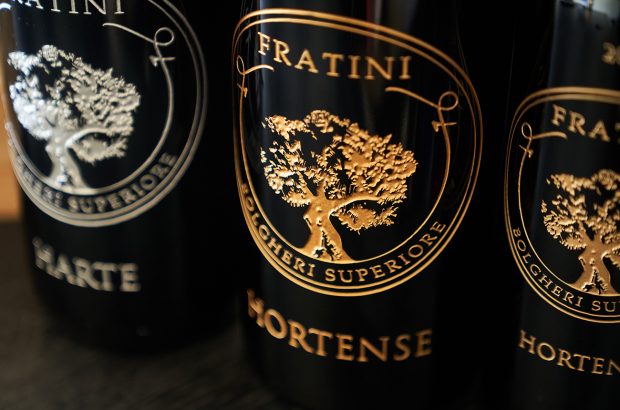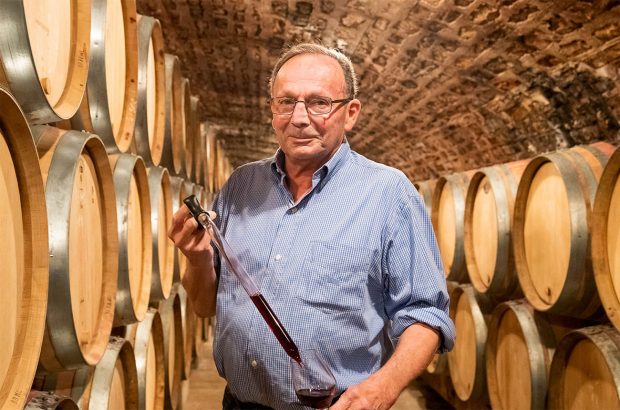Some of Italy’s best wines remain firmly under the radar for wine lovers. Richard Baudains explores why, and shines a light on names that deserve more recognition...
What exactly makes a wine ‘iconic’ is tricky to pin down, because the epithet does not denote any intrinsic quality but rather a status that may be acquired for a variety of reasons. Greatness clearly has something to do with it, but it is not exactly the same thing.
For example, there are many great Barolos but few truly iconic ones, which suggests that being unique, special and different in some way plays a part in being iconic.
At the same time, in the literal meaning of the word, iconic wines are a representation; the quintessential expression of something, which may be a terroir, or a grape variety, a person, a tradition or even a winemaking philosophy.
Sassicaia is an icon of style and elegance, the charismatic Angelo Gaja an iconic producer, Quintarelli’s Amarone an icon of a unique tradition.
{"content":"PC9wPgo8cD48ZGl2IGNsYXNzPSJhZC1jb250YWluZXIgYWQtY29udGFpbmVyLS1tb2JpbGUiPjxkaXYgaWQ9InBvc3QtaW5saW5lLTIiIGNsYXNzPSJpcGMtYWR2ZXJ0Ij48L2Rpdj48L2Rpdj48L3A+Cjxocj4KPGgzIHN0eWxlPSJ0ZXh0LWFsaWduOiBjZW50ZXIiPjxzdHJvbmc+U2Nyb2xsIGRvd24gZm9yIFJpY2hhcmQmIzgyMTc7cyAxMiB1bnN1bmcgaGVyb2VzIG9mIEl0YWxpYW4gd2luZTwvc3Ryb25nPjwvaDM+Cjxocj4KPHA+QW5vdGhlciBjaGFyYWN0ZXJpc3RpYyBpcyB0aGF0IHdpbmVzIGF0dGFpbiBpY29uaWMgc3RhdHVzIG92ZXIgdGltZSwgc28gaGlzdG9yeSBlbnRlcnMgaW50byB0aGUgZXF1YXRpb24gdG9vLiBJY29uaWMgd2luZXMgaGF2ZSBhIHN0b3J5IHRvIHRlbGwuIFRoZXkgYXJlIG9mdGVuIHJhcmUsIGFuZCB0aHVzIGRpZmZpY3VsdCB0byBvYnRhaW4sIGFuZCB0aGlzIGFsc28gYWRkcyB0byB0aGVpciBhdXJhLiBJY29ucyBpbnNwaXJlIHJlc3BlY3QgYW5kIGFkbWlyYXRpb24gYW5kIGV2ZW4g4oCTIHRha2luZyB1cCB0aGUgcmVsaWdpb3VzIGNvbm5vdGF0aW9uIOKAkyBhIGRlZ3JlZSBvZiBkZXZvdGlvbi48L3A+CjxoMj48c3Ryb25nPkFyZGVudCBhZG1pcmVyczwvc3Ryb25nPjwvaDI+CjxwPldoaWNoIGJyaW5ncyB1cyB0byB0aGUgaW1wb3J0YW50IHBvaW50OiB0aGF0IGljb25pYyB3aW5lcyBoYXZlIGEgZGV2b3RlZCBmb2xsb3dpbmcsIGJ1dCBub3QgbmVjZXNzYXJpbHkgYW1vbmcgYSB3aWRlciBwdWJsaWMuIEl0YWx5IGhhcyBtYW55IHdpbmVzLCBzdWNoIGFzIFNhc3NpY2FpYSwgR2FqYeKAmXMgU2FuIExvcmVuem8gYW5kIFF1aW50YXJlbGxp4oCZcyBBbWFyb25lICh0byBuYW1lIGJ1dCBhIGZldyksIHRoYXQgYXJlIHJlY29nbmlzZWQgaW50ZXJuYXRpb25hbGx5IGFzIOKAmGljb25pY+KAmSwgYnV0IHRoZXJlIGFyZSBtYW55IG90aGVycyB3aGljaCBpbnNwaXJlIHRoZSBzYW1lIGxldmVsIG9mIGRldm90aW9uIGFtb25nIHRoZWlyIGFkbWlyZXJzIGJ1dCBzbGlwIHVuZGVyIHRoZSByYWRhciBvZiB0aGUgd2luZSB3b3JsZCBhdCBsYXJnZS4gVGhlIHJlYXNvbnMgZm9yIHRoaXMgY2FuIGJlIG1hbnkuPC9wPgo8cD5UaGUgZmlyc3QgdGhpbmcgdG8gc2F5IGlzIHRoYXQgSXRhbGlhbiB3aW5lIGlzIGhhcmQgdG8gZ2V0IHRvIGtub3cgaW4gZGVwdGguIFRoZSBjb3VudHJ54oCZcyBwcm9kdWN0aW9uIGlzIGJvdGggaHVnZSBhbmQgZXh0cmVtZWx5IGRpdmVyc2lmaWVkLCBhbmQgZ2V0dGluZyBhIGhhbmRsZSBvbiBpdHMgbGl0ZXJhbGx5IHRob3VzYW5kcyBvZiBET0NzIGFuZCBET0NHcywgYXMgd2VsbCBhcyB0aGUgZXN0aW1hdGVkIDYwMCBuYXRpdmUgdmFyaWV0aWVzIGN1cnJlbnRseSBpbiB1c2UsIGlzIG5vIGVhc3kgdGFzay48L3A+CjxkaXYgY2xhc3M9ImFkLWNvbnRhaW5lciBhZC1jb250YWluZXItLW1vYmlsZSI+PGRpdiBpZD0icG9zdC1pbmxpbmUtMyIgY2xhc3M9ImlwYy1hZHZlcnQiPjwvZGl2PjwvZGl2Pgo8cD5BbGwgb2YgdGhpcyBtZWFucyB0aGF0IHdpbmVzIGZyb20gbGVzc2VyLWtub3duIHJlZ2lvbnMgb3IgbWlub3IgdmFyaWV0aWVzIGNhbiBvZnRlbiBnZXQgb3Zlcmxvb2tlZC48L3A+CjxoMj48c3Ryb25nPkhpZGRlbiB0cmVhc3VyZTwvc3Ryb25nPjwvaDI+CjxwPkluIHRvZGF54oCZcyB3b3JsZCBvZiBnbG9iYWwgY29tbXVuaWNhdGlvbiB0aGVyZSBhcmUgd2F5cyB0byBvdmVyY29tZSB0aGlzLCBidXQgaWNvbnMgd2lsbCBub3QgYWx3YXlzIHNlZWsgZ3JlYXRlciB2aXNpYmlsaXR5IGFuZCBzb21lIGV2ZW4gc2VlbSB0byBzaHVuIGl0LjwvcD4KPGRpdiBjbGFzcz0iYWQtY29udGFpbmVyIGFkLWNvbnRhaW5lci0tbW9iaWxlIj48ZGl2IGlkPSJwb3N0LWlubGluZS00IiBjbGFzcz0iaXBjLWFkdmVydCI+PC9kaXY+PC9kaXY+CjxwPklmIFZhbGVudGluaeKAmXMgd2luZXMgZnJvbSBBYnJ1enpvIGFyZSBub3QgbW9yZSB3aWRlbHkga25vd24sIGl0IG1pZ2h0IHdlbGwgYmUgYmVjYXVzZSwgYW5hY2hyb25pc3RpY2FsbHksIHRoZXkgaGF2ZSBuZWl0aGVyIGEgd2Vic2l0ZSBub3IgYSBwdWJsaXNoZWQgZW1haWwgYWRkcmVzcy4gVGhlbiB0aGVyZSBhcmUgY29tbWVyY2lhbCByZWFzb25zLiBNYW55IHNtYWxsZXIgcHJvZHVjZXJzIGhhdmUgbmVpdGhlciB0aGUgdGltZSBub3IgdGhlIHJlc291cmNlcyB0byBtYXJrZXQgdGhlbXNlbHZlcyBvciBkZXZlbG9wIGVmZmVjdGl2ZSBjaGFubmVscyBvZiBkaXN0cmlidXRpb24uPC9wPgo8cD5GaW5hbGx5LCBpY29ucyBtYXkgbG9zZSB2aXNpYmlsaXR5IGR1ZSB0byBjaGFuZ2luZyB3aW5lLWRyaW5raW5nIGZhc2hpb25zLiBUaGlzIGlzIHRoZSBjYXNlIG9mIHN3ZWV0IGFuZCBmb3J0aWZpZWQgd2luZXMsIGZvciBleGFtcGxlIOKAkyBJdGFsaWFuIHNwZWNpYWxpdGllcyB0aGF0IGFyZSBzYWRseSBkaXNhcHBlYXJpbmcgZnJvbSB3aW5lIGxpc3RzLiBGb3IgYWxsIHRoZXNlIHJlYXNvbnMsIHBhcmFkb3hpY2FsbHkgaW4gSXRhbHksIGljb25pYyB3aW5lcyBjYW4gaW4gc29tZSBjYXNlcyBhbHNvIGJlIGJlc3Qga2VwdCBzZWNyZXRzLjwvcD4KPGRpdiBjbGFzcz0iYWQtY29udGFpbmVyIGFkLWNvbnRhaW5lci0tbW9iaWxlIj48ZGl2IGlkPSJwb3N0LWlubGluZS01IiBjbGFzcz0iaXBjLWFkdmVydCI+PC9kaXY+PC9kaXY+Cjxocj4KPGgyPjxzdHJvbmc+QnVjY2k8L3N0cm9uZz48L2gyPgo8aDM+PHN0cm9uZz5WaWxsYSBCdWNjaSwgVmVyZGljY2hpbyBkZWkgQ2FzdGVsbGkgZGkgSmVzaSBSaXNlcnZhPC9zdHJvbmc+PC9oMz4KPHA+QW1wZWxpbyBCdWNjaSAoYnkgc3RyYW5nZSBjb2luY2lkZW5jZSBoaXMgbmFtZSBjb21lcyBmcm9tIHRoZSBzYW1lIEdyZWVrIHJvb3QgYXMg4oCYYW1wZWxvZ3JhcGh54oCZKSBoYXMgZGVmaW5lZCBoaW1zZWxmIGFzIGEgY29sbGVjdG9yIG9mIG9sZCB2aW5lcy48L3A+CjxwPkluIHRoZSAyMCBvciBzbyB5ZWFycyB0aGF0IGhlIGhhcyBiZWVuIHByb2R1Y2luZyB3aW5lIG9uIHRoZSBlc3RhdGUgZm91bmRlZCBieSBoaXMgZmF0aGVyLCBoZSBoYXMgc291Z2h0IG91dCBhbmQgYWNxdWlyZWQgYWJhbmRvbmVkIHBsb3RzIGluIHRoZSBjYWxjYXJlb3VzIGhpbGxzIG9mIENhc3RlbGxpIGRpIEplc2kgaW4gdGhlIE1hcmNoZSB0byBwdXQgdG9nZXRoZXIgYSB0b3RhbCBvZiAzMWhhLCAyNWhhIG9mIHdoaWNoIGFyZSBwbGFudGVkIHRvIFZlcmRpY2NoaW8uPC9wPgo8cD5FYWNoIHBsb3QgaXMgaGFydmVzdGVkIGFuZCB2aW5pZmllZCBzZXBhcmF0ZWx5IGFuZCBpbiB0aGUgY2FzZSBvZiB0aGUgVmlsbGEgQnVjY2ksIGFnZWQgZm9yIGF0IGxlYXN0IGEgeWVhciBpbiBsYXJnZSB0cmFkaXRpb25hbCBTbGF2b25pYW4gb2FrIGJhcnJlbHMgd2hpY2ggdGhlbXNlbHZlcyBhcmUgODAgeWVhcnMgb2xkLjwvcD4KPHA+VGhlIHdpbmVzIGZvciB0aGUgcmlzZXJ2YSBhcmUgdGhlbiBhc3NlbWJsZWQgYnkgQnVjY2kgYW5kIGxvbmctIHN0YW5kaW5nIG9lbm9sb2dpc3QgYW5kIG1hc3RlciB0YXN0ZXIgR2lvcmdpbyBHcmFpLiBUaGUgcHJvY2VkdXJlIGlzIHVuaXF1ZSBhbW9uZyBWZXJkaWNjaGlvcyBhbmQgd2l0aCBmZXcgcGFyYWxsZWxzIGluIEl0YWxpYW4gd2hpdGUgd2luZW1ha2luZyBhdCBsYXJnZTsgYW5kIHRoZSByZXN1bHQgaXMgd2luZSB3aXRoIHRlcnJvaXIgYXMgaXRzIHJhaXNvbiBk4oCZw6p0cmUuPC9wPgo8aHI+CjxoMj48c3Ryb25nPkF2aWdub25lc2k8L3N0cm9uZz48L2gyPgo8aDM+PHN0cm9uZz5PY2NoaW8gZGkgUGVybmljZSwgVmluIFNhbnRvIGRpIE1vbnRlcHVsY2lhbm88L3N0cm9uZz48L2gzPgo8cD5WaW4gc2FudG8gaGFzIGJlY29tZSBzb21ldGhpbmcgb2YgYSByYXJpdHkgaW4gVHVzY2FueS4gT2NjaGlvIGRpIFBlcm5pY2UgaXMgYSByYXJpdHkgYW1vbmcgcmFyaXRpZXMsIGJlY2F1c2UgaXQgaXMgbWFkZSBpbiBtaW51dGUgcXVhbnRpdGllcyBhbmQgbm90IHdpdGggdGhlIHVzdWFsIHdoaXRlIGdyYXBlcywgYnV0IHdpdGggPGEgaHJlZj0iaHR0cHM6Ly93d3cuZGVjYW50ZXIuY29tL3dpbmUvZ3JhcGUtdmFyaWV0aWVzL3Nhbmdpb3Zlc2UvIiB0YXJnZXQ9Il9ibGFuayIgcmVsPSJub29wZW5lciI+U2FuZ2lvdmVzZTwvYT4uPC9wPgo8cD5Bdmlnbm9uZXNpIGhhcyBrZXB0IHRoaXMgYWxtb3N0LWZvcmdvdHRlbiB0cmFkaXRpb24gYWxpdmUgaW4gaXRzIG1vc3QgYXV0aGVudGljIGZvcm0sIGRyeWluZyB0aGUgZ3JhcGVzIG5hdHVyYWxseSBhbmQgbGVhdmluZyB0aGUgY29uY2VudHJhdGVkIHN1Z2FyeSBtdXN0IHRvIGZlcm1lbnQgYW5kIGFnZSBvbiDigJhtb3RoZXLigJkgeWVhc3RzIGZvciB1cCB0byAxNSB5ZWFycyBpbiBzbWFsbCBjYXNrcyBleHBvc2VkIHRvIHRoZSBoZWF0IGFuZCB0aGUgY29sZCBvZiB0aGUgY2hhbmdpbmcgc2Vhc29ucyBpbiBhbiBvcGVuIGxvZnQgb24gaXRzIENhcGV6emluZSBlc3RhdGUuPC9wPgo8cD5UaGUgcmVzdWx0IGlzIG9uZSBvZiB0aGUgbW9zdCBleGNsdXNpdmUgKGFuZCBleHBlbnNpdmUpIGxpcXVpZHMgaW4gSXRhbGlhbiB3aW5lLiBQcm9kdWN0aW9uIGlzIHZhcmlhYmxlLCBidXQgdHlwaWNhbGx5IGNvbnNpc3RzIG9mIGFib3V0IDEsNTAwIGhhbGYgYm90dGxlcyBhbmQgYSBjZXJ0YWluIG51bWJlciBvZiAxMDBtbCBwaGlhbHMgdGhhdCB5b3UgY2FuIHNsaXAgaW50byB5b3VyIGhhbmQtbHVnZ2FnZSBmb3IgdGhlIGZsaWdodCBob21lLiBBdmlnbm9uZXNpIHdhcyB0YWtlbiBvdmVyIGluIDIwMDkgYW5kIGNvbnZlcnRlZCB0byBvcmdhbmljL2Jpb2R5bmFtaWMgdml0aWN1bHR1cmUgYnkgdGhlIEJlbGdpYW4gVmlyZ2luaWUgU2F2ZXJ5cy48L3A+Cjxocj4KPGgyPjxzdHJvbmc+QnJ1bm8gR2lhY29zYTwvc3Ryb25nPjwvaDI+CjxoMz48c3Ryb25nPlZpZ25hIExlIFJvY2NoZSwgRmFsbGV0dG8sIEJhcm9sbyBSaXNlcnZhPC9zdHJvbmc+PC9oMz4KPHA+UG9zc2libHkgQnJ1bm8gR2lhY29zYeKAmXMgZmFtb3VzbHkgdGFjaXR1cm4gbmF0dXJlIGhhcyBjb250cmlidXRlZCB0byB0aGUgaWNvbmljIHN0YXR1cyBoZSBlbmpveXMsIGFzIGEga2luZCBvZiBwYXJhZG94aWNhbCBzZWxmLXByb21vdGlvbiBpbiByZXZlcnNlLiBIb3dldmVyIHRoYXQgbWF5IGJlLCBiZWhpbmQgdGhvc2UgZGFyay1yaW1tZWQgc3BlY3RhY2xlcyBsaWVzIG9uZSBvZiBJdGFseeKAmXMgZ3JlYXRlc3Qgd2luZSBwcm9kdWNlcnMgb2YgYWxsIHRpbWUuPC9wPgo8cD5IZSBkaWQgaGlzIGFwcHJlbnRpY2VzaGlwIHNlbGVjdGluZyBncmFwZXMgZm9yIHRoZSBmYW1pbHkgYnVzaW5lc3MgYW5kIHVzZWQgYm91Z2h0LSBpbiBncmFwZXMgZm9yIHRoZSBmaXJzdCB3aW5lcyBoZSBtYWRlIGF0IGhpcyBvd24gY29tcGFueS48L3A+CjxwPkluIDE5ODIgaGUgYWNxdWlyZWQgdGhlIDNoYSBGYWxsZXR0byB2aW5leWFyZCBhdCBTZXJyYWx1bmdhLCB3aGljaCBpcyB0aGUgc291cmNlIG9mIGhpcyBCYXJvbG8uIFNvdXRod2VzdC1mYWNpbmcgaW4gYSBuYXR1cmFsIGFtcGhpdGhlYXRyZSwgd2l0aCBzYW5kc3RvbmUgYW5kIHNpbHR5IG1hcmwgc29pbHMsIGl0IGlzIGJ5IGNvbW1vbiBjb25zZW5zdXMgb25lIG9mIHRoZSBmaW5lc3QgY3J1cyBvZiB0aGUgTGFuZ2hlLjwvcD4KPHA+R2lhY29zYSBvbmNlIHNhaWQgdGhhdCBoZSBwcmVmZXJyZWQgaGlzIHdpbmVzIHRvIHNwZWFrIGZvciBoaW0gYW5kIHRoaXMgcGVyaGFwcyBleHBsYWlucyBoaXMgbGVnZW5kYXJ5IHBlcmZlY3Rpb25pc20uIEhlIHdpbGwgbmV2ZXIgYm90dGxlIGEgd2luZSB1bnRpbCBoZSBjb25zaWRlcnMgaXQgcmVhZHkgYW5kIHdpbGwgbmV2ZXIgYnJpbmcgb3V0IGEgdmludGFnZSB1bmxlc3MgaXQgY29tcGxldGVseSBjb252aW5jZXMgaGltLCB3aGljaCBtYWtlcyB0aGUgcmVsZWFzZSBvZiB0aGUgVmlnbmEgTGUgUm9jY2hlIFJpc2VydmEgYSB0cnVseSBpY29uaWMgZXZlbnQuPC9wPgo8aHI+CjxoMj48c3Ryb25nPkdpbmk8L3N0cm9uZz48L2gyPgo8aDM+PHN0cm9uZz5Db250cmFkYSBTYWx2YXJlbnphIFZlY2NoaWUgVmlnbmUsIFNvYXZlIENsYXNzaWNvPC9zdHJvbmc+PC9oMz4KPHA+SWYgU2FuZHJvIEdpbmnigJlzIGV4cXVpc2l0ZSB3aW5lcyBhcmUgbm90IGJldHRlciBrbm93biwgaXQgbWlnaHQgaGF2ZSBzb21ldGhpbmcgdG8gZG8gd2l0aCBoaXMgc2VsZi1lZmZhY2luZyBtb2Rlc3R5LCBvciBwZXJoYXBzIHdpdGggdGhlIGdlbmVyYWxseSBsb3cgZXhwZWN0YXRpb25zIHRoYXQgdGhlIG91dHNpZGUgd29ybGQgaG9sZHMgb2YgU29hdmUuPC9wPgo8cD5UaGUgQ29udHJhZGEgU2FsdmFyZW56YSBWZWNjaGllIFZpZ25lIGlzIGFueXRoaW5nIGJ1dCB0aGUgc3RlcmVvdHlwaWNhbCBzaW1wbGUsIGxpZ2h0LCBkcnkgc3VtbWVyIHdpbmUuIEdpbmnigJlzIGZhbWlseSBoYXMgb3duZWQgdGhlIFNhbHZhcmVuemEgdmluZXlhcmQgc2luY2UgMTg1Mi4gVGhlIGF2ZXJhZ2UgYWdlIG9mIHRoZSB2aW5lcywgYXJvdW5kIGEgdGhpcmQgb2Ygd2hpY2ggcHJlLWRhdGUgcGh5bGxveGVyYSwgaXMgYXJvdW5kIDEwMCB5ZWFycywgZ2l2ZSBvciB0YWtlIGEgZGVjYWRlLjwvcD4KPHA+R2luaSBhdHRlbmRlZCBvZW5vbG9naWNhbCBzY2hvb2wgYnV0IHNheXMgdGhhdCB3aGVuIGhlIHN0YXJ0ZWQgbWFraW5nIHdpbmUgaGUgaGFkIHRvIHVubGVhcm4gbXVjaCBvZiB3aGF0IGhlIGhhZCBiZWVuIHRhdWdodC4gRm9yIGV4YW1wbGUsIGhlIGhhcyBjb21wbGV0ZWx5IGVsaW1pbmF0ZWQgdGhlIHVzZSBvZiBzdWxwaGl0ZXMgZHVyaW5nIHZpbmlmaWNhdGlvbi48L3A+CjxwPlRoZSBncmFwZXMgZm9yIHRoZSBTYWx2YXJlbnphLCAxMDAlIEdhcmdhbmVnYSwgYXJlIHBpY2tlZCBhdCBmdWxsIHJpcGVuZXNzIGFuZCBmZXJtZW50ZWQgaW4gYmFycmVscyBvZiB2YXJ5aW5nIGNhcGFjaXRpZXMsIHdoZXJlIHRoZSB3aW5lIHJlbWFpbnMgZm9yIDEyIG1vbnRocy4gSXQgaXMgY2VsbGFyZWQgZm9yIGFub3RoZXIgeWVhciBiZWZvcmUgcmVsZWFzZSBhbmQgd2lsbCBjb250aW51ZSB0byBkZXZlbG9wIGZvciBhdCBsZWFzdCBhbm90aGVyIGRlY2FkZS48L3A+Cjxocj4KPGgyPjxzdHJvbmc+QnJhaWRhPC9zdHJvbmc+PC9oMj4KPGgzPjxzdHJvbmc+QnJpY2NvIGRlbGzigJlVY2NlbGxvbmUsIEJhcmJlcmEgZOKAmUFzdGk8L3N0cm9uZz48L2gzPgo8cD5CcmFpZGHigJlzIEJyaWNjbyBkZWxs4oCZVWNjZWxsb25lIGlzIGljb25pYyBiZWNhdXNlLCBhbHRob3VnaCBpcyB3YXMgcG9zc2libHkgbm90IHRoZSB2ZXJ5IGZpcnN0IEJhcmJlcmEgdG8gYWdlIGluIGJhcnJpcXVlLCBpdCB3YXMgdGhlIG9uZSB0aGF0IGNyZWF0ZWQgdGhlIGdlbnJlIHRoYXQgbGF1bmNoZWQgaHVtYmxlIEJhcmJlcmEgaW50byB0aGUgcmVhbG1zIG9mIHRoZSBzdXBlci1wcmVtaXVtIGluIHRoZSBlYXJseSAxOTgwcy48L3A+CjxwPkl0IGFsc28gb3dlZCBhIGxvdCBpbiB0aGUgcGFzdCB0byB0aGUgY2hhcmlzbWF0aWMsIGxhcmdlci10aGFuLWxpZmUgZmlndXJlIG9mIGl0cyBjcmVhdG9yIEdpYWNvbW8gQm9sb2duYSBhbmQgdG8gdGhlIGludm9sdmVtZW50IG9mIHRoZSBsZWdlbmRhcnkgY3JpdGljIGFuZCBwaGlsb3NvcGhlciBvZiBJdGFsaWFuIHdpbmUsIEx1aWdpIOKAmEdpbm\/igJkgVmVyb25lbGxpLCBpbiB0aGUgY29uY2VwdCBvZiB0aGUgcHJvamVjdC4gVGhlaXIgZ2VuaWFsIGludHVpdGlvbiB0aGF0IG5ldyBvYWsgd291bGQgaGFybW9uaXNlIHdpdGggQmFyYmVyYSB0byB0dXJuIHRoZSB2YXJpZXR5IGludG8gYSB3aW5lIG9mIHNpbGt5IHNtb290aCBlbGVnYW5jZSwgbWFya2VkIGEgbmV3IGVwb2NoIGZvciBJdGFsaWFuIHdpbmUuPC9wPgo8cD5Cb2xvZ25h4oCZcyBzb24gYW5kIGRhdWdodGVyIGNvbnRpbnVlIHByb2R1Y3Rpb24gdG9kYXkgZnJvbSB0aGUgc2FtZSBzb3V0aC0gZmFjaW5nIHNpbmdsZS12aW5leWFyZCBwbG90IGF0IFJvY2NoZXR0YSBUYW5hcm8gaW4gQXN0aS4gVGhlIGxhYmVsLCBpbiBpdHNlbGYgYW4gaWNvbiwgcmVtYWlucyB1bmNoYW5nZWQgZnJvbSB0aGUgb3JpZ2luYWwuPC9wPgo8aHI+CjxkaXYgaWQ9ImF0dGFjaG1lbnRfMzgzMTQ1IiBzdHlsZT0id2lkdGg6IDY2MHB4IiBjbGFzcz0id3AtY2FwdGlvbiBhbGlnbmNlbnRlciI+PGltZyBhcmlhLWRlc2NyaWJlZGJ5PSJjYXB0aW9uLWF0dGFjaG1lbnQtMzgzMTQ1IiBjbGFzcz0ibGF6eWxvYWQgYmx1ci11cCB3cC1pbWFnZS0zODMxNDUgc2l6ZS1mdWxsIiBzcmM9Imh0dHBzOi8vd3d3LmRlY2FudGVyLmNvbS93cC1jb250ZW50L3RoZW1lcy9zaW1iYS10aGVtZS9hc3NldHMvaW1hZ2VzL3BsYWNlaG9sZGVyLnBuZyIgZGF0YS1zcmM9Imh0dHBzOi8va2V5YXNzZXRzLnRpbWVpbmN1ay5uZXQvaW5zcGlyZXdwL2xpdmUvd3AtY29udGVudC91cGxvYWRzL3NpdGVzLzM0LzIwMTgvMDEvVGllZmVuYnJ1bm5lci1GZW5uYmVyZy12aW5leWFyZC5qcGciIGFsdD0iVGllZmVuYnJ1bm5lciBGZW5uYmVyZyB2aW5leWFyZCIgd2lkdGg9IjY1MCIgaGVpZ2h0PSI0MzAiIGRhdGEtc2l6ZXM9ImF1dG8iIGRhdGEtc3Jjc2V0PSJodHRwczovL2tleWFzc2V0cy50aW1laW5jdWsubmV0L2luc3BpcmV3cC9saXZlL3dwLWNvbnRlbnQvdXBsb2Fkcy9zaXRlcy8zNC8yMDE4LzAxL1RpZWZlbmJydW5uZXItRmVubmJlcmctdmluZXlhcmQuanBnIDY1MHcsIGh0dHBzOi8va2V5YXNzZXRzLnRpbWVpbmN1ay5uZXQvaW5zcGlyZXdwL2xpdmUvd3AtY29udGVudC91cGxvYWRzL3NpdGVzLzM0LzIwMTgvMDEvVGllZmVuYnJ1bm5lci1GZW5uYmVyZy12aW5leWFyZC0xMzV4ODkuanBnIDEzNXcsIGh0dHBzOi8va2V5YXNzZXRzLnRpbWVpbmN1ay5uZXQvaW5zcGlyZXdwL2xpdmUvd3AtY29udGVudC91cGxvYWRzL3NpdGVzLzM0LzIwMTgvMDEvVGllZmVuYnJ1bm5lci1GZW5uYmVyZy12aW5leWFyZC0zMDB4MTk4LmpwZyAzMDB3LCBodHRwczovL2tleWFzc2V0cy50aW1laW5jdWsubmV0L2luc3BpcmV3cC9saXZlL3dwLWNvbnRlbnQvdXBsb2Fkcy9zaXRlcy8zNC8yMDE4LzAxL1RpZWZlbmJydW5uZXItRmVubmJlcmctdmluZXlhcmQtNjMweDQxNy5qcGcgNjMwdywgaHR0cHM6Ly9rZXlhc3NldHMudGltZWluY3VrLm5ldC9pbnNwaXJld3AvbGl2ZS93cC1jb250ZW50L3VwbG9hZHMvc2l0ZXMvMzQvMjAxOC8wMS9UaWVmZW5icnVubmVyLUZlbm5iZXJnLXZpbmV5YXJkLTMyMHgyMTIuanBnIDMyMHcsIGh0dHBzOi8va2V5YXNzZXRzLnRpbWVpbmN1ay5uZXQvaW5zcGlyZXdwL2xpdmUvd3AtY29udGVudC91cGxvYWRzL3NpdGVzLzM0LzIwMTgvMDEvVGllZmVuYnJ1bm5lci1GZW5uYmVyZy12aW5leWFyZC02MjB4NDEwLmpwZyA2MjB3IiBzaXplcz0iKG1heC13aWR0aDogNjUwcHgpIDEwMHZ3LCA2NTBweCIgLz48cCBpZD0iY2FwdGlvbi1hdHRhY2htZW50LTM4MzE0NSIgY2xhc3M9IndwLWNhcHRpb24tdGV4dCI+VGllZmVuYnJ1bm5lciYjODIxNztzIEZlbm5iZXJnIHZpbmV5YXJkPC9wPjwvZGl2Pgo8aDI+PHN0cm9uZz5UaWVmZW5icnVubmVyPC9zdHJvbmc+PC9oMj4KPGgzPjxzdHJvbmc+RmVsZG1hcnNjaGFsbCB2b24gRmVubmVyIE3DvGxsZXItVGh1cmdhdTwvc3Ryb25nPjwvaDM+CjxwPlRoZSAxOXRoLWNlbnR1cnkgcG9ydHJhaXQgb2YgRmVsZG1hcnNjaGFsbCBGcmFueiBQaGlsaXBwIEZlbm5lciB2b24gRmVubmViZXJnLCB3aXRoIGhpcyBqYXVudGlseSB3b3JuIG1pbGl0YXJ5IGNhcCwgaXMgdGhlIGNlbnRyZXBpZWNlIG9mIHRoZSBBbHRvIEFkaWdl4oCZcyBtb3N0IGljb25pYyB3aW5lIGxhYmVsLCByZW1pbmRpbmcgdXMgb2YgdGhlIGNlbnRyYWwgRXVyb3BlYW4gY3VsdHVyZSBvZiB0aGUgYm9yZGVyIHJlZ2lvbiBhbmQgdGhlIG9yaWdpbiBvZiBtYW55IG9mIGl0cyBncmFwZSB2YXJpZXRpZXMuPC9wPgo8cD5UaGUgTcO8bGxlci1UaHVyZ2F1IGdyYXBlIGlzIG5vdCBoZWxkIGluIHBhcnRpY3VsYXJseSBoaWdoIGVzdGVlbSBpbiBUcmVudGluby1BbHRvIEFkaWdlLCB3aGVyZSBpdCB1c3VhbGx5IG1ha2VzIGxpZ2h0IGFuZCBzbGlnaHRseSBlcGhlbWVyYWwsIGNpdHJ1c3N5IHdpbmVzLiBUaWVmZW5icnVubmVy4oCZcyBGZWxkbWFyc2NoYWxsIGhvd2V2ZXIgaXMgc29tZXRoaW5nIGVsc2UgYWx0b2dldGhlci48L3A+CjxwPkdyb3duIGF0IDEsMDAwbSBvbiBvbmUgb2YgdGhlIGhpZ2hlc3Qgc2l0ZXMgaW4gdGhlIHJlZ2lvbiwgaXQgaGFzIGEgZGVwdGgsIGNvbXBsZXhpdHkgYW5kIHBvdGVudGlhbCBmb3IgYWdlaW5nIHdoaWNoIGdpdmUgcGxhdXNpYmlsaXR5IHRvIG9uZSBzY2llbnRpZmljIHRoZW9yeSB0aGF0IHRoZSB2YXJpZXR5IGlzIG5vdCBhZnRlciBhbGwgYSBjcm9zc2luZyBvZiBTaWx2YW5lciBhbmQgUmllc2xpbmcsIGJ1dCBkb2VzIGhhdmUgYSBzdHJvbmcgZ2VuZXRpYyBjb25uZWN0aW9uIHdpdGggdGhlIG5vYmxlIFJpZXNsaW5nLjwvcD4KPHA+VmluaWZpZWQgd2l0aCBsb25nIGxlZXMgYWdlaW5nIGJ1dCB3aXRob3V0IG9haywgaXQgaXMgcmVsZWFzZWQgdHdvIHllYXJzIGFmdGVyIHRoZSB2aW50YWdlIGFuZCB0ZW5kcyB0byBwZWFrIGFmdGVyIGFub3RoZXIgdHdvIG9yIHRocmVlLjwvcD4KPGhyPgo8aDI+PHN0cm9uZz5DYWdnaWFubzwvc3Ryb25nPjwvaDI+CjxoMz48c3Ryb25nPlZpZ25hIE1hY2NoaWEgZGVpIEdvdHRpLCBUYXVyYXNpPC9zdHJvbmc+PC9oMz4KPHA+VGF1cmFzaSBoYXMgYmVlbiBjYWxsZWQgdGhlIDxhIGhyZWY9Imh0dHBzOi8vd3d3LmRlY2FudGVyLmNvbS93aW5lL3dpbmUtcmVnaW9ucy9iYXJvbG8vIiB0YXJnZXQ9Il9ibGFuayIgcmVsPSJub29wZW5lciI+QmFyb2xvPC9hPiBvZiB0aGUgc291dGguIFRoZSBBZ2xpYW5pY28gZ3JhcGUgZnJvbSB3aGljaCBpdCBpcyBtYWRlIGRvZXMgaGF2ZSB0cmFpdHMgaW4gY29tbW9uIHdpdGggUGllZG1vbnTigJlzIE5lYmJpb2xvOiB0YW5uaW4sIGhpZ2ggYWNpZGl0eSBhbmQgYSBwcm9kaWdpb3VzIGNhcGFjaXR5IGZvciBhZ2VpbmcuPC9wPgo8cD5ZZXQgVGF1cmFzaSBoYXNu4oCZdCBhbHdheXMgZW5qb3llZCB0aGUgc2FtZSBwcmVzdGlnZSBhcyB0aGUgcmVkcyBvZiB0aGUgTGFuZ2hlLiBUaGUgcmVhc29ucyBsaWUgaW4gcGFydCBpbiB0aGUgcmVtb3RlbmVzcyBvZiB0aGUgSXJwaW5pYW4gaGlsbHMgd2hlcmUgaXQgaXMgbWFkZSBhbmQgaW4gcGFydCB0byBpbmNvbnNpc3RlbnQgd2luZW1ha2luZyBpbiB0aGUgcGFzdC48L3A+CjxwPklmIFRhdXJhc2kgaGFzIG5vdyBzdGFydGVkIHRvIGdhaW4gdGhlIHJlc3BlY3QgaXQgZGVzZXJ2ZXMsIGl0IGlzIGRvd24gdG8gYSBuZXcgZ2VuZXJhdGlvbiBvZiBxdWFsaXR5IHByb2R1Y2Vycy4gT25lIHRoYXQgaGFzIGFjaGlldmVkIGljb25pYyBzdGF0dXMgaXMgQW50b25pbyBDYWdnaWFubywgYSBtb2Rlcm5pc3QgaW4gdGhlIGJlc3Qgc2Vuc2UuPC9wPgo8cD5IZSB3YXMgb25lIG9mIHRoZSBmaXJzdCB0byBwbGFudCBhdCBoaWdoIGRlbnNpdHkgYW5kIHRvIGJvdHRsZSBhIHNpbmdsZS0gdmluZXlhcmQgc2VsZWN0aW9uLiBIZSB3YXMgYWxzbyB0aGUgZmlyc3QgdG8gZW1wbG95IGJhcnJpcXVlcyB0byB0YW1lIHRoZSBhZ2dyZXNzaXZlIHRhbm5pbnMgb2YgQWdsaWFuaWNvIOKAkyBhbmQgdml0YWxseSB0byBoYXZlIG1hc3RlcmVkIHRoZWlyIHVzZS48L3A+Cjxocj4KPGgyPjxzdHJvbmc+Q2FzdGVsbOKAmWluIFZpbGxhPC9zdHJvbmc+PC9oMj4KPGgzPjxzdHJvbmc+Q2hpYW50aSBDbGFzc2ljbzwvc3Ryb25nPjwvaDM+CjxwPlByaW5jZXNzIENvcmFsaWEgUGlnbmF0ZWxsaSBkZWxsYSBMZW9uZXNzYSByZWlnbnMgb3ZlciA1MmhhIG9mIHZpbmV5YXJkIGF0IENhc3RlbG51b3ZvIEJlcmFyZGVuZ2EgaW4gdGhlIHNvdXRoIG9mIHRoZSBDaGlhbnRpIENsYXNzaWNvIGhpbGxzLjwvcD4KPHA+SGVyIGFwcHJvYWNoIHRvIHdpbmUgcHJvZHVjdGlvbiBpcyBzaW1wbGUgYW5kIGRpcmVjdC4gU2hlIGhhcyBhbHdheXMgaW5zaXN0ZWQgdGhhdCBoZXIgaW50ZW50IGlzIHRvIG1ha2UgdGhlIHdpbmVzIHRoYXQgc2hlIGxpa2VzIGJlc3QsIGluZGVwZW5kZW50IG9mIHRoZSBzdHlsaXN0aWMgZmFkcyB0aGF0IGluZmx1ZW5jZSBjb21tZXJjaWFsIGRlbWFuZC4gRm9sbG93aW5nIHRoaXMgcHJpbmNpcGxlIGZvciBtb3JlIHRoYW4gMzAgeWVhcnMsIHNoZSBoYXMgZXN0YWJsaXNoZWQgQ2FzdGVsbOKAmWluIFZpbGxhIGFzIGFuIGljb24gb2YgY2xhc3NpY2lzbSwgYSBsaXR0bGUgZGV0YWNoZWQgcGVyaGFwcyAoYW5kIGxpdHRsZSBpbmNsaW5lZCB0byBwcm9tb3Rpb24pLCBidXQgd2l0aCBpbXBlY2NhYmxlIHF1YWxpdHkgYW5kIGNvbnNpc3RlbmN5IHRoYXQgc3BlYWsgZm9yIHRoZW1zZWx2ZXMuPC9wPgo8cD5TaGUgbWFrZXMgbW9yZSBwb3dlcmZ1bCB3aW5lcyB0aGFuIGhlciBzdHJhaWdodCBDaGlhbnRpIENsYXNzaWNvIOKAkyB0aGUgUmlzZXJ2YSBQb2dnaW8gZGVsbGUgUm9zZSBoYXMgdGhlIHN0cnVjdHVyZSB0byBhZ2UgZm9yIGRlY2FkZXMg4oCTIGJ1dCBpdCBpcyB0aGlzIOKAmGJhc2lj4oCZIGN1dsOpZSB0aGF0IHBlcmhhcHMgYmVzdCByZXByZXNlbnRzIHRoZSBlc3NlbmNlIG9mIENoaWFudGkgQ2xhc3NpY28uPC9wPgo8cD5Eb27igJl0IGFzc3VtZSB0aGF0IGl0IGlzIGEgc2ltcGxlIHdpbmUuIEl0IGFnZXMgbG9uZ2VyIGluIHdvb2QgdGhhbiBhbnkgb3RoZXIgbm9uLXJpc2VydmEgQ2hpYW50aSwgYnV0IGl0IHN0aWxsIGV4cHJlc3NlcyB0aGUgam95b3VzIGZydWl0LWRyaXZlbiBkcmlua2FiaWxpdHkgYW5kIHRyYW5zcGFyZW50IHRlcnJvaXIgY2hhcmFjdGVyIG9mIFRoZSBSZWFsIFRoaW5nLjwvcD4KPGhyPgo8ZGl2IGlkPSJhdHRhY2htZW50XzM4MzE0NCIgc3R5bGU9IndpZHRoOiA2NjBweCIgY2xhc3M9IndwLWNhcHRpb24gYWxpZ25jZW50ZXIiPjxpbWcgYXJpYS1kZXNjcmliZWRieT0iY2FwdGlvbi1hdHRhY2htZW50LTM4MzE0NCIgY2xhc3M9Imxhenlsb2FkIGJsdXItdXAgd3AtaW1hZ2UtMzgzMTQ0IHNpemUtZnVsbCIgc3JjPSJodHRwczovL3d3dy5kZWNhbnRlci5jb20vd3AtY29udGVudC90aGVtZXMvc2ltYmEtdGhlbWUvYXNzZXRzL2ltYWdlcy9wbGFjZWhvbGRlci5wbmciIGRhdGEtc3JjPSJodHRwczovL2tleWFzc2V0cy50aW1laW5jdWsubmV0L2luc3BpcmV3cC9saXZlL3dwLWNvbnRlbnQvdXBsb2Fkcy9zaXRlcy8zNC8yMDE4LzAxL09jY2hpcGludGktaGFydmVzdC5qcGciIGFsdD0iT2NjaGlwaW50aSBoYXJ2ZXN0IiB3aWR0aD0iNjUwIiBoZWlnaHQ9IjQzMCIgZGF0YS1zaXplcz0iYXV0byIgZGF0YS1zcmNzZXQ9Imh0dHBzOi8va2V5YXNzZXRzLnRpbWVpbmN1ay5uZXQvaW5zcGlyZXdwL2xpdmUvd3AtY29udGVudC91cGxvYWRzL3NpdGVzLzM0LzIwMTgvMDEvT2NjaGlwaW50aS1oYXJ2ZXN0LmpwZyA2NTB3LCBodHRwczovL2tleWFzc2V0cy50aW1laW5jdWsubmV0L2luc3BpcmV3cC9saXZlL3dwLWNvbnRlbnQvdXBsb2Fkcy9zaXRlcy8zNC8yMDE4LzAxL09jY2hpcGludGktaGFydmVzdC0xMzV4ODkuanBnIDEzNXcsIGh0dHBzOi8va2V5YXNzZXRzLnRpbWVpbmN1ay5uZXQvaW5zcGlyZXdwL2xpdmUvd3AtY29udGVudC91cGxvYWRzL3NpdGVzLzM0LzIwMTgvMDEvT2NjaGlwaW50aS1oYXJ2ZXN0LTMwMHgxOTguanBnIDMwMHcsIGh0dHBzOi8va2V5YXNzZXRzLnRpbWVpbmN1ay5uZXQvaW5zcGlyZXdwL2xpdmUvd3AtY29udGVudC91cGxvYWRzL3NpdGVzLzM0LzIwMTgvMDEvT2NjaGlwaW50aS1oYXJ2ZXN0LTYzMHg0MTcuanBnIDYzMHcsIGh0dHBzOi8va2V5YXNzZXRzLnRpbWVpbmN1ay5uZXQvaW5zcGlyZXdwL2xpdmUvd3AtY29udGVudC91cGxvYWRzL3NpdGVzLzM0LzIwMTgvMDEvT2NjaGlwaW50aS1oYXJ2ZXN0LTMyMHgyMTIuanBnIDMyMHcsIGh0dHBzOi8va2V5YXNzZXRzLnRpbWVpbmN1ay5uZXQvaW5zcGlyZXdwL2xpdmUvd3AtY29udGVudC91cGxvYWRzL3NpdGVzLzM0LzIwMTgvMDEvT2NjaGlwaW50aS1oYXJ2ZXN0LTYyMHg0MTAuanBnIDYyMHciIHNpemVzPSIobWF4LXdpZHRoOiA2NTBweCkgMTAwdncsIDY1MHB4IiAvPjxwIGlkPSJjYXB0aW9uLWF0dGFjaG1lbnQtMzgzMTQ0IiBjbGFzcz0id3AtY2FwdGlvbi10ZXh0Ij5PY2NoaXBpbnRpIGhhcnZlc3Q8L3A+PC9kaXY+CjxoMj48c3Ryb25nPk9jY2hpcGludGk8L3N0cm9uZz48L2gyPgo8aDM+PHN0cm9uZz5Hcm90dGUgQWx0ZSwgQ2VyYXN1b2xvIGRpIFZpdHRvcmlhIENsYXNzaWNvPC9zdHJvbmc+PC9oMz4KPHA+QXJpYW5uYSBPY2NoaXBpbnRpIGNvbWVzIGZyb20gYSB3aW5lbWFraW5nIGZhbWlseSAoaGVyIHVuY2xlIEdpdXN0byBPY2NoaXBpbnRpIGlzIG9uZSBvZiB0aGUgcGFydG5lcnMgaW4gdGhlIGhpc3RvcmljIENPUyB3aW5lcnkgYXQgVml0dG9yaWEpLiBXaXRoIGRlZ3JlZXMgaW4gdml0aWN1bHR1cmUgYW5kIG9lbm9sb2d5IGJlaGluZCBoZXIsIHNoZSBzdGFydGVkIG91dCB3aXRoIGp1c3QgMWhhIG9mIHZpbmV5YXJkLCBhIHN1cmZhY2UgYXJlYSB3aGljaCBoYXMgbm93IGdyb3duIHRvIDI1aGEuPC9wPgo8cD5PY2NoaXBpbnRpIGlzIGEgaGlnaC1wcm9maWxlIGNoYW1waW9uIG9mIG5hdHVyYWwgd2luZW1ha2luZyB3aG8gaGFzIHN1Y2NlZWRlZCBpbiB0YWtpbmcgbXVjaCBhbWJpZ3VpdHkgb3V0IG9mIHRoZSB0ZXJtIOKAmG5hdHVyYWzigJkgYnkgc2ltcGx5IG1ha2luZyBncmVhdCB3aW5lcyB0aGF0IHRhc3RlIG9mIHRoZWlyIHBsYWNlIG9mIG9yaWdpbi4gU2hlIGdyb3dzIGFsYmVyZWxsby1wcnVuZWQgbmF0aXZlIHZhcmlldGllcyBvbiB0aGUgc2FuZHktY2FsY2FyZW91cyBzb2lscyBvZiBWaXR0b3JpYSBpbiBzb3V0aGVhc3Rlcm4gU2ljaWx5LjwvcD4KPHA+R3JvdHRlIEFsdGUgaXMgYW4gb2xkLXZpbmUsIDUwOjUwIGJsZW5kIG9mIEZyYXBwYXRvIGFuZCBOZXJvIGTigJlBdm9sYSwgd2hpY2ggbWFycmllcyB0aGUgZnJhZ3JhbmNlIG9mIHRoZSBmaXJzdCB3aXRoIHRoZSBib2R5IGFuZCBicm9vZGluZywgYml0dGVyIGRhcmsgY2hvY29sYXRlIG9mIHRoZSBzZWNvbmQuIEFnZWQgZm9yIHRocmVlIHRvIGZvdXIgeWVhcnMgaW4gMjVobCBTbGF2b25pYW4gb2FrIGJhcnJlbHMsIGl0IGlzIG9ubHkgcHJvZHVjZWQgaW4gdGhlIGJlc3QgdmludGFnZXMuPC9wPgo8aHI+CjxoMj48c3Ryb25nPkZlcnJhcmk8L3N0cm9uZz48L2gyPgo8aDM+PHN0cm9uZz5SaXNlcnZhIGRlbCBGb25kYXRvcmUgR2l1bGlvIEZlcnJhcmk8L3N0cm9uZz48L2gzPgo8cD5HaXVsaW8gRmVycmFyaSB3YXMgYSBwaW9uZWVyaW5nIHBvbHlnbG90IG51cnNlcnltYW4gZnJvbSBUcmVudGlubyB3aXRoIHR3byBncmVhdCBwYXNzaW9ucyBpbiBsaWZlOiBDaGFyZG9ubmF5LCB3aGljaCBoZSB3YXMgaW5zdHJ1bWVudGFsIGluIGludHJvZHVjaW5nIGludG8gSXRhbHkgb24gYSB3aWRlIHNjYWxlLCBhbmQgQ2hhbXBhZ25lLjwvcD4KPHA+Rm9sbG93aW5nIGhpcyBpbnR1aXRpb24gdGhhdCB0aGUgc2xvcGVzIG9mIHRoZSBBZGlnZSB2YWxsZXkgb2ZmZXJlZCB0aGUgZ3Jvd2luZyBjb25kaXRpb25zIGZvciBtYWtpbmcgZ3JlYXQgc3BhcmtsaW5nIHdpbmVzLCBoZSBzdGFydGVkIGV4cGVyaW1lbnRpbmcgd2l0aCB0aGUgQ2hhbXBhZ25lIG1ldGhvZCBhcm91bmQgdGhlIGJlZ2lubmluZyBvZiB0aGUgbGFzdCBjZW50dXJ5IGFuZCBieSAxOTA2IHdhcyBhbHJlYWR5IHBpY2tpbmcgdXAgZ29sZCBtZWRhbHMgZm9yIHRoZSByZXN1bHRzLjwvcD4KPHA+VGhlIHdpbmUgd2hpY2ggYmVhcnMgaGlzIG5hbWUgd2FzIGZpcnN0IG1hZGUgYnkgdGhlIGN1cnJlbnQgb3duZXJzIG9mIHRoZSBob3VzZSwgdGhlIEx1bmVsbGkgZmFtaWx5LCBpbiAxOTcyIGFuZCBoYXMgYmVlbiBwcm9kdWNlZCBpbiB0aGUgc2FtZSBzdHlsZSBldmVyIHNpbmNlLiBUaGUgUmlzZXJ2YSBkZWwgRm9uZGF0b3JlIGlzIGV4dHJhIGJydXQgaW4gc3R5bGUgYW5kIGNvbWVzIGZyb20gdmluZXlhcmRzIG9uIHRoZSBQaWFuaXp6YSBlc3RhdGUgbG9jYXRlZCA1MDBtLTYwMG0gYWJvdmUgc2VhIGxldmVsIG9uIHRoZSBjb29sIHNpZGUgb2YgdGhlIHJpdmVyIHZhbGxleS4gSXQgYWdlcyBvbiBpdHMgbGVlcyBmb3IgMTAgeWVhcnMgYW5kIHdpbGwgaGFwcGlseSBrZWVwIGFuZCBpbXByb3ZlIGZvciBhbm90aGVyIGRlY2FkZS48L3A+Cjxocj4KPGgyPjxzdHJvbmc+TWFyY28gRGUgQmFydG9saTwvc3Ryb25nPjwvaDI+CjxoMz48c3Ryb25nPlZlY2NoaW8gU2FtcGVyaSwgTWFyc2FsYTwvc3Ryb25nPjwvaDM+CjxwPklmIHlvdSBnb29nbGUg4oCYTWFyc2FsYeKAmSB5b3UgZ2V0IG1vcmUgcGFnZXMgYWJvdXQgY29va2luZyBzYXVjZXMgdGhhbiB3aW5lLiBNYXJzYWxhIHRoZSB3aW5lIGlzIG1ha2luZyBhIGxpbWl0ZWQgY29tZWJhY2ssIGJ1dCBmb3IgZGVjYWRlcyBpdCBoYXMgYmVlbiBvbmUgb2YgdGhvc2UgbmVnbGVjdGVkIEl0YWxpYW4gc3BlY2lhbGl0aWVzIHRoYXQgYXJlIGVhc2llciB0byBmaW5kIGluIHJlZmVyZW5jZSBib29rcyB0aGFuIG9uIGEgd2luZSBtZXJjaGFudOKAmXMgc2hlbGYuIEZvciB0aGlzIHJlYXNvbiBNYXJjbyBEZSBCYXJ0b2xp4oCZcyBWZWNjaGlvIFNhbXBlcmkgZml0cyBleGFjdGx5IGludG8gdGhlIGNhdGVnb3J5IG9mIGxpdHRsZS1rbm93biBpY29uOyBmb3IgaWNvbiBpdCBpcywgYnV0IG9uZSB5b3XigJlsbCBub3QgbGlrZWx5IGZpbmQgYXQgeW91ciBoaWdoIHN0cmVldCByZXRhaWxlci48L3A+CjxwPlZlY2NoaW8gU2FtcGVyaSBpcyBhIDIwLXllYXItb2xkIHNvbGVyYSAoPGVtPnBlcnBldHVvPC9lbT4pIHByZXNlcnZlZCBpbiBvYWsgYW5kIGNoZXN0bnV0IGJhcnJlbHMgdG8gd2hpY2ggNSUgbmV3IHdpbmUgaXMgYWRkZWQgZXZlcnkgeWVhci4gSXQgaXMgbWFkZSBlbnRpcmVseSB3aXRoIEdyaWxsbywgdGhlIHRyYWRpdGlvbmFsIE1hcnNhbGEgZ3JhcGUsIGFuZCBpdCBpcyBub3QgZm9ydGlmaWVkLjwvcD4KPHA+SW4gdGhpcyByZXNwZWN0IGl0IGNvbm5lY3RzIHdpdGggdGhlIG5hdHVyYWwgd2luZXMgd2hpY2ggdGhlIEVuZ2xpc2ggbmF2eSBmb3J0aWZpZWQgaW4gdGhlIG1pZC0xOXRoIGNlbnR1cnkgZm9yIGxvbmcgc2VhIGpvdXJuZXlzIGFuZCB3aGljaCBldmVudHVhbGx5IGVuZGVkIHVwIGluIHlvdXIgY2hpY2tlbiBtYXJzYWxhLjwvcD4KPGhyPgo8ZGl2IGlkPSJhdHRhY2htZW50XzM4MzE0NiIgc3R5bGU9IndpZHRoOiA2NjBweCIgY2xhc3M9IndwLWNhcHRpb24gYWxpZ25jZW50ZXIiPjxpbWcgYXJpYS1kZXNjcmliZWRieT0iY2FwdGlvbi1hdHRhY2htZW50LTM4MzE0NiIgY2xhc3M9Imxhenlsb2FkIGJsdXItdXAgd3AtaW1hZ2UtMzgzMTQ2IHNpemUtZnVsbCIgc3JjPSJodHRwczovL3d3dy5kZWNhbnRlci5jb20vd3AtY29udGVudC90aGVtZXMvc2ltYmEtdGhlbWUvYXNzZXRzL2ltYWdlcy9wbGFjZWhvbGRlci5wbmciIGRhdGEtc3JjPSJodHRwczovL2tleWFzc2V0cy50aW1laW5jdWsubmV0L2luc3BpcmV3cC9saXZlL3dwLWNvbnRlbnQvdXBsb2Fkcy9zaXRlcy8zNC8yMDE4LzAxL3RyZWJiaWFuby1kYWJydXp6by5qcGciIGFsdD0iVmFsZW50aW5pJ3MgdW5pcXVlIGxhYmVsIHVwIGNsb3NlIiB3aWR0aD0iNjUwIiBoZWlnaHQ9IjQzMCIgZGF0YS1zaXplcz0iYXV0byIgZGF0YS1zcmNzZXQ9Imh0dHBzOi8va2V5YXNzZXRzLnRpbWVpbmN1ay5uZXQvaW5zcGlyZXdwL2xpdmUvd3AtY29udGVudC91cGxvYWRzL3NpdGVzLzM0LzIwMTgvMDEvdHJlYmJpYW5vLWRhYnJ1enpvLmpwZyA2NTB3LCBodHRwczovL2tleWFzc2V0cy50aW1laW5jdWsubmV0L2luc3BpcmV3cC9saXZlL3dwLWNvbnRlbnQvdXBsb2Fkcy9zaXRlcy8zNC8yMDE4LzAxL3RyZWJiaWFuby1kYWJydXp6by0xMzV4ODkuanBnIDEzNXcsIGh0dHBzOi8va2V5YXNzZXRzLnRpbWVpbmN1ay5uZXQvaW5zcGlyZXdwL2xpdmUvd3AtY29udGVudC91cGxvYWRzL3NpdGVzLzM0LzIwMTgvMDEvdHJlYmJpYW5vLWRhYnJ1enpvLTMwMHgxOTguanBnIDMwMHcsIGh0dHBzOi8va2V5YXNzZXRzLnRpbWVpbmN1ay5uZXQvaW5zcGlyZXdwL2xpdmUvd3AtY29udGVudC91cGxvYWRzL3NpdGVzLzM0LzIwMTgvMDEvdHJlYmJpYW5vLWRhYnJ1enpvLTYzMHg0MTcuanBnIDYzMHcsIGh0dHBzOi8va2V5YXNzZXRzLnRpbWVpbmN1ay5uZXQvaW5zcGlyZXdwL2xpdmUvd3AtY29udGVudC91cGxvYWRzL3NpdGVzLzM0LzIwMTgvMDEvdHJlYmJpYW5vLWRhYnJ1enpvLTMyMHgyMTIuanBnIDMyMHcsIGh0dHBzOi8va2V5YXNzZXRzLnRpbWVpbmN1ay5uZXQvaW5zcGlyZXdwL2xpdmUvd3AtY29udGVudC91cGxvYWRzL3NpdGVzLzM0LzIwMTgvMDEvdHJlYmJpYW5vLWRhYnJ1enpvLTYyMHg0MTAuanBnIDYyMHciIHNpemVzPSIobWF4LXdpZHRoOiA2NTBweCkgMTAwdncsIDY1MHB4IiAvPjxwIGlkPSJjYXB0aW9uLWF0dGFjaG1lbnQtMzgzMTQ2IiBjbGFzcz0id3AtY2FwdGlvbi10ZXh0Ij5WYWxlbnRpbmkmIzgyMTc7cyB1bmlxdWUgbGFiZWwgdXAgY2xvc2U8L3A+PC9kaXY+CjxoMj48c3Ryb25nPlZhbGVudGluaTwvc3Ryb25nPjwvaDI+CjxoMz48c3Ryb25nPlRyZWJiaWFubyBkJiM4MjE3O0FicnV6em88L3N0cm9uZz48L2gzPgo8cD5WYWxlbnRpbmkgZXNjaGV3cyBjb252ZW50aW9uYWwgbGFiZWxzLiBQZXJoYXBzIHRoZSBvbmx5IGRlc2NyaXB0aW9uIHRvIHVzZSBmb3IgdGhpcyB1bmlxdWUgcHJvZHVjZXIgaXMgdGhlIHRlcm0g4oCYYXJ0aXNhbuKAmSB3aGljaCBGcmFuY2VzY28gUGFvbG8gVmFsZW50aW5pIGFwcGxpZXMgdG8gaGltc2VsZi4gTWFueSBvZiB0aGUgdGVjaG5pY2FsIGRldGFpbHMgb2YgaGlzIHdpbmVtYWtpbmcgYXJlIG9ic2N1cmUsIHNpbmNlIG5laXRoZXIgaGUgbm9yIGhpcyBmYXRoZXIgRWRvYXJkbyBiZWZvcmUgaGltIGhhdmUgZXZlciBzcG9rZW4gd2lsbGluZ2x5IGFib3V0IHRoZW0sIGFuZCB0aGUgY2VsbGFycyBhcmUgbmV2ZXIgc2hvd24gdG8gdmlzaXRvcnMuPC9wPgo8ZGl2IGNsYXNzPSJpbmplY3Rpb24iPjwvZGl2Pgo8cD5XaGF0IHdlIGRvIGtub3cgaXMgdGhhdCB0aGVpciBUcmViYmlhbm8gZmVybWVudHMgd2l0aCBpbmRpZ2Vub3VzIHllYXN0cyBhdCBuYXR1cmFsIHRlbXBlcmF0dXJlcywgYWdlcyBpbiBsYXJnZSBiYXJyZWxzLCBpcyBub3QgZmlsdGVyZWQgb3IgY2xhcmlmaWVkLCBhbmQgdGhhdCBzZWxlY3Rpb24gaXMgdmVyeSByaWdvcm91cy4gQWxsIHRoaXMgY29udHJpYnV0ZXMgdG8gYSBwcm9kaWdpb3VzIGNhcGFjaXR5IGZvciBhZ2VpbmcgaW4gdGhlIGJvdHRsZSwgd2hpY2ggYWxtb3N0IGtub3dzIG5vIGxpbWl0cy48L3A+CjxwPkFub3RoZXIgbWFqb3IgZmFjdG9yIGlzIHRoZSB2YXJpZXR5IGl0c2VsZi4gVHJlYmJpYW5vIGlzIHVzdWFsbHkgYSB3b3JraG9yc2UgZ3JhcGUsIGJ1dCBpbiBBYnJ1enpvIHRoZSBsb2NhbCBiaW90eXBlIGtub3duIGFzIFN2YWdhcmluYSBtYWtlcyB3aW5lcyB3aXRoIHN0cnVjdHVyZSBhbmQgYXJvbWEgd2hpY2ggc2V0IHRoZW0gYXBhcnQgZnJvbSBhbnkgb3RoZXIgVHJlYmJpYW5vIGluIEl0YWx5LjwvcD4KPGhyPgo8cD4K"}
12 lesser-known icon wines of Italy:
{}
{"wineId":"17753","displayCase":"standard","paywall":true}
{"wineId":"17754","displayCase":"standard","paywall":true}
{"wineId":"17755","displayCase":"standard","paywall":true}
{"wineId":"17756","displayCase":"standard","paywall":true}
{"wineId":"17757","displayCase":"standard","paywall":true}
{"wineId":"17758","displayCase":"standard","paywall":true}
{"wineId":"17759","displayCase":"standard","paywall":true}
{"wineId":"17760","displayCase":"standard","paywall":true}
{"wineId":"17761","displayCase":"standard","paywall":true}
{"wineId":"17762","displayCase":"standard","paywall":true}
{"wineId":"17763","displayCase":"standard","paywall":true}
{"wineId":"17764","displayCase":"standard","paywall":true}
{}
Richard Baudains is a DWWA Regional co-Chair for Italy, and has written on the country’s wines for Decanter since 1989
You may also like:















